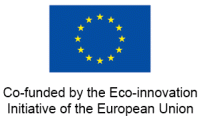Main menu
You are here
Biogas digestate: composition, use, logistics, processing
Composition
| unit | n | 10 % quantil | arithmetic average | 90 % quantil | |
| DM content | [%] | 1875 | 2.7 | 5.7 | 9.1 | organic matter in % of DM | [%] | 1709 | 55.2 | 69.3 | 82.4 |
| pH value | - | 1856 | 7.5 | 7.9 | 8.3 |
| N | [% of DM] | 1652 | 4.9 | 10.4 | 18.1 |
| NH4-N | [% of DM] | 1822 | 1.6 | 6.0 | 12.6 |
| K2O | [% of DM] | 1294 | 2.2 | 5.3 | 8.8 |
| P2O5 | [% of DM] | 1292 | 1.9 | 3.8 | 5.5 |
| CaO | [% of DM] | 1136 | 2.1 | 4.7 | 8.1 |
| Mg | [% of DM] | 1133 | 0.3 | 0.7 | 1.3 |
| Cr | [mg/kg DM] | 1091 | 6.5 | 15.1 | 25.9 |
| Cd | [mg/kg DM] | 1068 | 0.2 | 0.4 | 0.6 |
| Pb | [mg/kg DM] | 1081 | 2.1 | 5.8 | 9.6 |
| Zn | [mg/kg DM] | 1095 | 157.4 | 311.1 | 494.0 |
| Cu | [mg/kg DM] | 1095 | 34.9 | 87.5 | 151.6 |
| Hg | [mg/kg DM] | 1071 | 0.0 | 0.1 | 0.2 |
The table on the right gives an overview on results of analyses of about 1 800 collected digestate samples during the time frame 2009-2012, in several Member States of the EU that was published by European Biogas Association (EBA).
Use
Digestate can be directly applied after production to the nearby agricultural land, however, an accumulation of biogas plants in certain regions and their increasing number leads to an oversupply of digestate. The digestate needs to be transported to regions with nutrient deficits or otherwise processed. The transportation to distant areas causes logistical problems because the digestate consists of 95% water. Spreading is usually restricted to a few months in a year. In winter time it is normally not permitted as excess precipitation during these months can cause the fertiliser to run off the land and potentially contaminate local water sources. Big storage capacity is needed to buffer the digestate. If sufficient land area is not available, digestates have to be pretreated (e.g. sludge separation, NH3-separation, dewatering) before further use. Solid fractions are often separated from the digestate to undergo further composting. The separated liquid fraction of the digestate is in some cases partly re-circulated for substrate homogenisation or further processed i.e. aerobically purified. Digestate specific intense smell also negatively influences the quality of life of nearby population.
Processing
Digestate can be processed by different technologies. Each of the technologies has benefits and also limitations. The best solution for a specific biogas plant depends on its possibilities and needs.
Many biogas plants have introduced separation of liquid (liquor) and solid (cake) phases of the digestate. The solid phase is more suitable for fertalization use for both logistic and agro-technical reasons. The processes for liquor treatment are presented in the table below (summarized from Pell Frischmann Consultants Ltd: Enhancement and treatment of digestates from anaerobic digestion, 2012).
| Type | Technologies | Benefits | Challenges |
| Physical | Membrane purification | Purified water potentially acceptable for direct discharge; concentrated liquors lead to reduced volumes for further treatment (N stripping) or possible use as liquid fertilisers | Concentrate disposal is still required, although reuse may be possible (as process water); membranes must be protected from particulates and large volumes of solids to prevent fouling and physical damage; high energy requirement; fouling |
| Thermal | Surface Scraped Heat Exchanger (HRS) | Reduced transport volume; potentially no further treatment of condensate required; concentrated nutrient rich product; use of heat eligible for RHI | Acidic product may limit available land bank |
| Biological | Reed Beds | Low power and OPEX: sanitisation; stabilisation; volume reduction | Large land area required; long operational time (10-15 years) to produce a stable product |
| Biological | Biological oxidation | Nitrified effluent can be better utilised as a fertiliser; effluent is suitable for concentration by evaporation; reduced disposal cost | High power consumption |
| Biological | Algal Pond/Photo bio reactor | Improves quality of liquid fraction; produces algae which can either be sold or converted into biodiesel; removes CO2 from biogas | Large surface area required for ponds; careful control required for bioreactors |
| Biological | Bioethanol production | Conversion of digestate fibre into valuable fuel source; potential for reuse of digested liquor | Early stage of development; chemical consumption |
| Biological | Microbial Fuel Cells (MFC) | Power production; COD removal | Cathode stability; membrane costs; transition from laboratory scale to industrial application |
| Nutrient recovery | Struvite Precipitation | Recovery of struvite which has value as a fertiliser; struvite is recovered as easily handled pellets; prevents fouling of pipe work and plant | Contamination with solids; market security; complexity |
| Nutrient recovery | Ammonia Stripping | Ammonia removed from digestate potentially removing restrictions on land application, due to nitrogen content; concentrated ammonium sulphate stream can be used as liquid fertiliser or feedstock for other processes | High temperature and pH; precipitation of ammonium sulphate within washing column; fouling |
| Nutrient recovery (chemical) | Membrane Contactor | Single step process for recovering ammonia as ammonium sulphate | Membrane fouling |
| Nutrient recovery (chemical) | Ion Exchange | Recovery of concentrated ammonia | Fouling of adsorbent bed; maintaining bed capacity after multiple regeneration cycles |
| Chemical | Alkaline Stabilisation | Pathogen kill; improved digestate quality; simple process; suppression of H2S | Potential ammonia release (odour); not suitable for application to all soil types; high chemical requirement |




